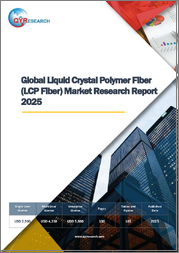
|
시장보고서
상품코드
1489454
LCP(Liquid Crystal Polymer) 시장 예측(-2030년) : 유형별, 용도별, 지역별 세계 분석Liquid Crystal Polymers Market Forecasts to 2030 - Global Analysis By Type (Thermotropic LCP and Lyotropic LCP), Application (Electrical and Electronics, Automotive, Industrial and Other Applications) and By Geography |
||||||
Stratistics MRC에 따르면 세계의 LCP(Liquid Crystal Polymer) 시장은 2023년에 15억 4,000만 달러를 차지하며, 예측 기간 중 CAGR은 10.2%로 성장하며, 2030년에는 30억 4,000만 달러에 달할 것으로 예측되고 있습니다.
LCP(Liquid Crystal Polymer)는 고성능 엔지니어링 열가소성 플라스틱으로, 액체와 고체를 모두 닮은 규칙적인 분자 구조가 특징인 고성능 열가소성수지입니다. 뛰어난 기계적, 열적, 화학적 특성으로 잘 알려진 LCP는 낮은 열팽창 계수, 높은 강성, 난연성, 우수한 치수 안정성을 나타냅니다. 전자, 자동차, 항공우주, 산업 분야에서 널리 사용되는 LCP는 정밀도와 성능이 요구되는 환경에서 범용성과 신뢰성을 제공합니다.
일본전자정보기술산업협회(JEITIA)의 조사에 따르면 2018년 세계 전자정보기술 생산은 전년 대비 8% 증가한 2조 9,345억 달러에 달했습니다. 이 조사는 2019년에도 4% 증가한 3조 458억 달러에 달할 것으로 예측했습니다.
전자 산업에서 수요 증가
LCP는 우수한 전기적 특성, 치수 안정성 및 높은 내열성을 가지고 있으며, 커넥터, 소켓, 인쇄 회로 기판과 같은 전자 부품에 가장 적합한 소재입니다. 전자기기의 소형화와 고성능 소재에 대한 업계의 요구가 증가함에 따라 LCP에 대한 수요가 증가하여 시장 성장에 기여하고 있습니다.
LCP의 높은 비용
LCP는 제조 공정이 복잡하고 특수 장비가 필요하기 때문에 제조 비용이 비쌉니다. 이러한 비용 요소는 가격에 민감한 용도와 산업에서 LCP의 채택을 제한하고 시장 성장을 저해하고 있습니다. 또한 LCP를 제품에 적용하고자 하는 중소기업에게도 높은 비용 부담은 큰 도전이 될 수 있습니다.
커스터마이징 및 재료 혁신
커스터마이징과 재료 혁신은 LCP 시장에 큰 기회를 제공하고 있으며, LCP는 새로운 배합 및 블렌드 개발을 통해 특정 용도 요구 사항을 충족하도록 조정할 수 있으며, LCP 제조업체와 최종사용자 간의 협업을 통해 맞춤형 솔루션을 창출할 수 있습니다. 맞춤형 솔루션의 창출은 시장의 잠재력을 확대할 수 있습니다. 가공성 개선 및 특성 향상과 같은 LCP 재료의 혁신은 새로운 용도를 개척하고 시장 성장을 가속할 수 있습니다.
제한적인 가공성
LCP는 가공 범위가 좁고 성형시 온도와 전단 속도를 정밀하게 제어해야 합니다. 이러한 복잡한 가공은 일관된 부품 품질을 달성하는 데 어려움을 겪을 수 있으며, 특수 장비와 전문 지식이 필요할 수 있습니다. 가공성의 한계로 인해, 특히 필요한 기술력이 없는 제조업체는 LCP를 채택하는 것을 주저할 수 있습니다.
COVID-19의 영향 :
COVID-19는 LCP(Liquid Crystal Polymer) 시장에 다양한 영향을 미쳤습니다. 전자 산업에서는 원격 근무와 온라인 교육으로 인해 장비 및 부품에 대한 수요가 급증한 반면, 공급망과 제조 운영의 혼란이 LCP(Liquid Crystal Polymer) 시장에 영향을 미쳤습니다. 그러나 팬데믹으로 인해 소형화 및 고성능 전자제품으로의 전환이 가속화되고 있으며, LCP(Liquid Crystal Polymer) 시장의 장기적인 성장이 기대되고 있습니다.
예측 기간 중 열전소성 LCP 분야가 가장 클 것으로 예상됩니다.
예측 기간 중 열경화성 LCP 부문이 가장 큰 시장을 형성할 것으로 예상됩니다. 열경화성 LCP는 우수한 기계적 특성, 내화학성 및 열 안정성을 나타내며 다양한 용도에 적합합니다. 복잡한 형상으로 성형할 수 있고 대량 생산 공정에 적합하기 때문에 시장에서 우위를 점하고 있습니다. 전자, 자동차, 산업 분야에서 열경화성 LCP에 대한 수요가 증가하면서 이 분야의 성장을 주도하고 있습니다.
자동차 분야가 예측 기간 중 가장 높은 CAGR을 나타낼 것으로 예상됩니다.
자동차 분야는 예측 기간 중 가장 높은 CAGR을 보일 것으로 예상되며, LCP는 경량, 고강도, 내열성 등의 특성으로 인해 자동차 용도에서 사용이 증가하고 있습니다. 자동차 업계가 경량화 및 연비 개선에 집중하면서 커넥터, 센서, 구조 부품 등의 부품에 LCP 채택이 증가하고 있습니다. 전기자동차와 첨단운전자보조시스템(ADAS) 증가 추세는 자동차 분야에서 LCP에 대한 수요를 더욱 증가시키고 있습니다.
가장 큰 점유율을 차지하는 지역 :
아시아태평양이 LCP(Liquid Crystal Polymer) 시장을 주도하고 있습니다. 이 지역, 특히 중국, 일본, 한국과 같은 국가들의 대규모 전자제품 제조거점은 LCP 수요를 촉진하는 중요한 요인으로 작용하고 있습니다. 아시아태평양에는 대형 LCP 제조업체들이 존재하며, 전자 산업이 빠르게 성장하고 있는 것도 이 지역의 압도적인 시장 지위에 기여하고 있습니다. 또한 아시아태평양의 자동차 생산 증가와 첨단 기술에 대한 관심은 시장 성장을 더욱 촉진하고 있습니다.
CAGR이 가장 높은 지역 :
아시아태평양에서도 LCP(Liquid Crystal Polymer) 시장이 빠르게 성장할 것으로 예상됩니다. 이 지역의 중산층 확대, 가처분 소득 증가, 전자제품에 대한 소비자 수요 증가가 LCP 시장의 성장을 촉진하고 있습니다. 또한 이 지역 정부는 전자 및 자동차를 포함한 하이테크 산업의 발전을 촉진하고 있으며, 이는 LCP 수요를 촉진할 것으로 예상됩니다. 이 지역의 비용 경쟁력 있는 제조 능력과 숙련된 노동력의 존재는 이 지역의 높은 성장 잠재력을 더욱 촉진하고 있습니다.
무료 맞춤형 서비스 :
이 보고서를 구독하는 고객은 다음과 같은 무료 맞춤화 옵션 중 하나를 사용할 수 있습니다. :
- 기업 개요
- 추가 시장 기업의 종합적인 프로파일링(최대 3사)
- 주요 기업의 SWOT 분석(최대 3사)
- 지역 세분화
- 고객의 관심에 따른 주요 국가별 시장 추정치, 예측, CAGR(주: 타당성 확인에 따름)
- 경쟁사 벤치마킹
- 제품 포트폴리오, 지역적 입지, 전략적 제휴를 기반으로 한 주요 기업 벤치마킹
목차
제1장 주요 요약
제2장 서문
- 개요
- 이해관계자
- 조사 범위
- 조사 방법
- 데이터 마이닝
- 데이터 분석
- 데이터 검증
- 조사 어프로치
- 조사 정보원
- 1차 조사 정보원
- 2차 조사 정보원
- 전제조건
제3장 시장 동향 분석
- 촉진요인
- 억제요인
- 기회
- 위협
- 용도 분석
- 신흥 시장
- COVID-19의 영향
제4장 Porter's Five Forces 분석
- 공급 기업의 교섭력
- 구매자의 교섭력
- 대체품의 위협
- 신규 진출업체의 위협
- 경쟁 기업간 경쟁 관계
제5장 세계의 LCP(Liquid Crystal Polymer) 시장 : 유형별
- 서모트로픽 LCP
- 리오트로픽 LCP
제6장 세계의 LCP(Liquid Crystal Polymer) 시장 : 용도별
- 전기·전자
- 커넥터
- 인쇄회로기판(PCB)
- 소켓
- 기타 전자 용도
- 자동차
- 엔진 부품
- 연료 시스템 컴포넌트
- 변속기 부품
- 기타 자동차 용도
- 산업
- 베어링
- 기어
- 기계 부품
- 기타 산업 용도
- 항공우주 및 방위
- 항공기 부품
- 방위 장비
- 기타 항공우주 및 방위 용도
- 헬스케어
- 의료기기
- 의약품 포장
- 기타 헬스케어 용도
- 기타 용도
제7장 세계의 LCP(Liquid Crystal Polymer) 시장 : 지역별
- 북미
- 미국
- 캐나다
- 멕시코
- 유럽
- 독일
- 영국
- 이탈리아
- 프랑스
- 스페인
- 기타 유럽
- 아시아태평양
- 일본
- 중국
- 인도
- 호주
- 뉴질랜드
- 한국
- 기타 아시아태평양
- 남미
- 아르헨티나
- 브라질
- 칠레
- 기타 남미
- 중동 및 아프리카
- 사우디아라비아
- 아랍에미리트
- 카타르
- 남아프리카공화국
- 기타 중동 및 아프리카
제8장 주요 발전
- 계약, 파트너십, 협업, 합병사업
- 인수합병
- 신제품 발매
- 사업 확대
- 기타 주요 전략
제9장 기업 프로파일링
- Avient Corporation
- Celanese Corporation
- Chang Chun Group
- Ensinger
- Grupa Azoty ZAK S.A.
- Kuraray Co., Ltd.
- Lehmann & Voss & Co. KG
- Polyplastics Co., Ltd.
- RTP Company
- SABIC
- Samsung Fine Chemicals
- Shanghai Kinlita Chemical Co., Ltd.
- Shanghai Liansheng Chemical Co., Ltd.
- Shenzhen Wote Advanced Materials Co., Ltd.
- Solvay
- Sumitomo Chemical Co., Ltd.
- Toray Industries, Inc.
- Ueno Fine Chemicals Industry, Ltd.
According to Stratistics MRC, the Global Liquid Crystal Polymers Market is accounted for $1.54 billion in 2023 and is expected to reach $3.04 billion by 2030 growing at a CAGR of 10.2% during the forecast period. Liquid Crystal Polymers (LCPs) are high-performance engineering thermoplastics characterized by an ordered molecular structure resembling both liquids and solids. Known for exceptional mechanical, thermal, and chemical properties, LCPs exhibit low coefficients of thermal expansion, high stiffness, flame resistance, and excellent dimensional stability. Widely used in electronics, automotive, aerospace, and industrial applications, LCPs offer versatility and reliability in demanding environments requiring precision and performance.
According to a survey by the Japan Electronics and Information Technology Industries Association (JEITIA), global electronics and information technology production surged by 8% in 2018 compared to the previous year, reaching US$2,934.5 billion. The survey further predicts a 4% increase in 2019, bringing the projected total to US$3,045.8 billion.
Market Dynamics:
Driver:
Growing demand from electronics industry
The growing demand for LCPs in the electronics industry is a key driver for the market. LCPs offer excellent electrical properties, dimensional stability, and high heat resistance, making them ideal for electronic components such as connectors, sockets, and printed circuit boards. The increasing miniaturization of electronic devices and the need for high-performance materials in the industry are fueling the demand for LCPs, contributing to market growth.
Restraint:
High cost of LCPs
The complex manufacturing process and the need for specialized equipment contribute to the higher production costs of LCPs. This cost factor limits the adoption of LCPs in price-sensitive applications and industries, hindering market growth. The high cost also poses challenges for small and medium-sized companies looking to incorporate LCPs into their products.
Opportunity:
Customization and material innovation
Customization and material innovation present significant opportunities in the LCP market. LCPs can be tailored to meet specific application requirements through the development of new formulations and blends. Collaborations between LCP manufacturers and end-users to create customized solutions can expand the market potential. Innovations in LCP materials, such as improved processability and enhanced properties, can open up new application areas and drive market growth.
Threat:
Limited processability
LCPs have a narrow processing window and require precise control over temperature and shear rates during molding. This complexity in processing can lead to challenges in achieving consistent part quality and may require specialized equipment and expertise. The limited processability can deter some manufacturers from adopting LCPs, especially those without the necessary technical capabilities.
Covid-19 Impact:
The COVID-19 pandemic has had a mixed impact on the liquid crystal polymers market. While the electronics industry experienced a surge in demand for devices and components due to remote work and online education, disruptions in supply chains and manufacturing operations affected the liquid crystal polymers market. However, the pandemic has also accelerated the trend towards miniaturization and high-performance electronics, which is expected to drive long-term growth in the liquid crystal polymers market.
The thermotropic LCP segment is expected to be the largest during the forecast period
The thermotropic LCP segment is expected to be the largest during the forecast period. Thermotropic LCPs exhibit excellent mechanical properties, chemical resistance, and thermal stability, making them suitable for a wide range of applications. Their ability to be molded into complex shapes and their compatibility with high-volume manufacturing processes contribute to their dominant market position. The growing demand for thermotropic LCPs in the electronics, automotive, and industrial sectors is driving the segment's growth.
The automotive segment is expected to have the highest CAGR during the forecast period
The automotive segment is expected to have the highest CAGR during the forecast period. LCPs are increasingly being used in automotive applications due to their lightweight, high strength, and thermal resistance properties. The automotive industry's focus on weight reduction and improved fuel efficiency is driving the adoption of LCPs in components such as connectors, sensors, and structural parts. The growing trend towards electric vehicles and advanced driver assistance systems (ADAS) further fuels the demand for LCPs in the automotive sector.
Region with largest share:
The Asia Pacific region is positioned to dominate the liquid crystal polymers market. The region's large electronics manufacturing base, particularly in countries like China, Japan, and South Korea, is a key factor driving the demand for LCPs. The presence of major LCP manufacturers and the rapid growth of the electronics industry in the region contribute to its dominant market position. Additionally, the increasing automotive production and the focus on advanced technologies in the Asia Pacific region further support market growth.
Region with highest CAGR:
The Asia Pacific region also anticipates rapid growth in the liquid crystal polymers market. The region's expanding middle class, rising disposable incomes, and increasing consumer demand for electronic devices are driving the growth of the LCP market. Governments in the region are also promoting the development of high-tech industries, including electronics and automotive, which is expected to fuel the demand for LCPs. The region's cost-competitive manufacturing capabilities and the presence of a skilled workforce further contribute to its high growth potential.
Key players in the market
Some of the key players in Liquid Crystal Polymers Market include Avient Corporation, Celanese Corporation, Chang Chun Group, Ensinger, Grupa Azoty ZAK S.A., Kuraray Co., Ltd., Lehmann & Voss & Co. KG, Polyplastics Co., Ltd., RTP Company, SABIC, Samsung Fine Chemicals, Shanghai Kinlita Chemical Co., Ltd., Shanghai Liansheng Chemical Co., Ltd., Shenzhen Wote Advanced Materials Co., Ltd., Solvay, Sumitomo Chemical Co., Ltd., Toray Industries, Inc. and Ueno Fine Chemicals Industry, Ltd.
Key Developments:
In October 2022, Chang Chun Arizona, a subsidiary of Chang Chun Group, broke ground on its first U.S. manufacturing facility in Casa Grande, Arizona. The facility will produce electronic-grade chemicals to support the semiconductor industry and is expected to be operational in 2023.
In July 2022, Sumitomo Chemical Advanced Technologies has developed a new long-fiber thermoplastic liquid crystal polymer, namely, SUMIKASUPER to be further utilized across optical fiber applications.
In September 2021, Grupa Azoty ZAK S.A. introduced changes in its Oxoplast segment, expanding its product portfolio with specialty plasticizers under the Oxofine brand.
Types Covered:
- Thermotropic LCP
- Lyotropic LCP
Applications Covered:
- Electrical and Electronics
- Automotive
- Industrial
- Aerospace and Defense
- Healthcare
- Other Applications
Regions Covered:
- North America
- US
- Canada
- Mexico
- Europe
- Germany
- UK
- Italy
- France
- Spain
- Rest of Europe
- Asia Pacific
- Japan
- China
- India
- Australia
- New Zealand
- South Korea
- Rest of Asia Pacific
- South America
- Argentina
- Brazil
- Chile
- Rest of South America
- Middle East & Africa
- Saudi Arabia
- UAE
- Qatar
- South Africa
- Rest of Middle East & Africa
What our report offers:
- Market share assessments for the regional and country-level segments
- Strategic recommendations for the new entrants
- Covers Market data for the years 2021, 2022, 2023, 2026, and 2030
- Market Trends (Drivers, Constraints, Opportunities, Threats, Challenges, Investment Opportunities, and recommendations)
- Strategic recommendations in key business segments based on the market estimations
- Competitive landscaping mapping the key common trends
- Company profiling with detailed strategies, financials, and recent developments
- Supply chain trends mapping the latest technological advancements
Free Customization Offerings:
All the customers of this report will be entitled to receive one of the following free customization options:
- Company Profiling
- Comprehensive profiling of additional market players (up to 3)
- SWOT Analysis of key players (up to 3)
- Regional Segmentation
- Market estimations, Forecasts and CAGR of any prominent country as per the client's interest (Note: Depends on feasibility check)
- Competitive Benchmarking
- Benchmarking of key players based on product portfolio, geographical presence, and strategic alliances
Table of Contents
1 Executive Summary
2 Preface
- 2.1 Abstract
- 2.2 Stake Holders
- 2.3 Research Scope
- 2.4 Research Methodology
- 2.4.1 Data Mining
- 2.4.2 Data Analysis
- 2.4.3 Data Validation
- 2.4.4 Research Approach
- 2.5 Research Sources
- 2.5.1 Primary Research Sources
- 2.5.2 Secondary Research Sources
- 2.5.3 Assumptions
3 Market Trend Analysis
- 3.1 Introduction
- 3.2 Drivers
- 3.3 Restraints
- 3.4 Opportunities
- 3.5 Threats
- 3.6 Application Analysis
- 3.7 Emerging Markets
- 3.8 Impact of Covid-19
4 Porters Five Force Analysis
- 4.1 Bargaining power of suppliers
- 4.2 Bargaining power of buyers
- 4.3 Threat of substitutes
- 4.4 Threat of new entrants
- 4.5 Competitive rivalry
5 Global Liquid Crystal Polymers Market, By Type
- 5.1 Introduction
- 5.2 Thermotropic LCP
- 5.3 Lyotropic LCP
6 Global Liquid Crystal Polymers Market, By Application
- 6.1 Introduction
- 6.2 Electrical and Electronics
- 6.2.1 Connectors
- 6.2.2 Printed Circuit Boards (PCBs)
- 6.2.3 Sockets
- 6.2.4 Other Electronic Applications
- 6.3 Automotive
- 6.3.1 Engine Components
- 6.3.2 Fuel System Components
- 6.3.3 Transmission Parts
- 6.3.4 Other Automotive Applications
- 6.4 Industrial
- 6.4.1 Bearings
- 6.4.2 Gears
- 6.4.3 Machinery Components
- 6.4.4 Other Industrial Applications
- 6.5 Aerospace and Defense
- 6.5.1 Aircraft Components
- 6.5.2 Defense Equipment
- 6.5.3 Other Aerospace and Defense Applications
- 6.6 Healthcare
- 6.6.1 Medical Devices
- 6.6.2 Pharmaceutical Packaging
- 6.6.3 Other Healthcare Applications
- 6.7 Other Applications
7 Global Liquid Crystal Polymers Market, By Geography
- 7.1 Introduction
- 7.2 North America
- 7.2.1 US
- 7.2.2 Canada
- 7.2.3 Mexico
- 7.3 Europe
- 7.3.1 Germany
- 7.3.2 UK
- 7.3.3 Italy
- 7.3.4 France
- 7.3.5 Spain
- 7.3.6 Rest of Europe
- 7.4 Asia Pacific
- 7.4.1 Japan
- 7.4.2 China
- 7.4.3 India
- 7.4.4 Australia
- 7.4.5 New Zealand
- 7.4.6 South Korea
- 7.4.7 Rest of Asia Pacific
- 7.5 South America
- 7.5.1 Argentina
- 7.5.2 Brazil
- 7.5.3 Chile
- 7.5.4 Rest of South America
- 7.6 Middle East & Africa
- 7.6.1 Saudi Arabia
- 7.6.2 UAE
- 7.6.3 Qatar
- 7.6.4 South Africa
- 7.6.5 Rest of Middle East & Africa
8 Key Developments
- 8.1 Agreements, Partnerships, Collaborations and Joint Ventures
- 8.2 Acquisitions & Mergers
- 8.3 New Product Launch
- 8.4 Expansions
- 8.5 Other Key Strategies
9 Company Profiling
- 9.1 Avient Corporation
- 9.2 Celanese Corporation
- 9.3 Chang Chun Group
- 9.4 Ensinger
- 9.5 Grupa Azoty ZAK S.A.
- 9.6 Kuraray Co., Ltd.
- 9.7 Lehmann & Voss & Co. KG
- 9.8 Polyplastics Co., Ltd.
- 9.9 RTP Company
- 9.10 SABIC
- 9.11 Samsung Fine Chemicals
- 9.12 Shanghai Kinlita Chemical Co., Ltd.
- 9.13 Shanghai Liansheng Chemical Co., Ltd.
- 9.14 Shenzhen Wote Advanced Materials Co., Ltd.
- 9.15 Solvay
- 9.16 Sumitomo Chemical Co., Ltd.
- 9.17 Toray Industries, Inc.
- 9.18 Ueno Fine Chemicals Industry, Ltd.



















